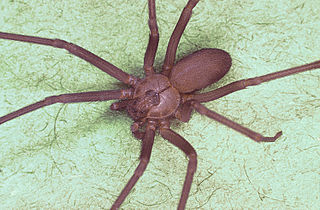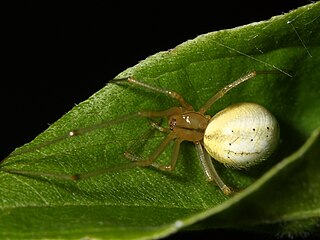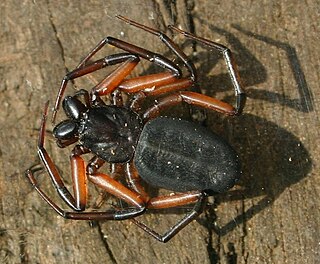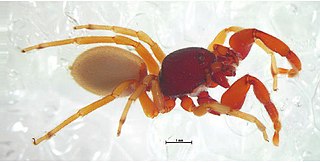
Sicariidae is a family of six-eyed venomous spiders known for their potentially necrotic bites. The family consists of three genera and about 160 species. Well known spiders in this family include the brown recluse spider and the six-eyed sand spider.

Theridiidae, also known as the tangle-web spiders, cobweb spiders and comb-footed spiders, is a large family of araneomorph spiders first described by Carl Jakob Sundevall in 1833. This diverse, globally distributed family includes over 3,000 species in 124 genera, and is the most common arthropods found in human dwellings throughout the world.

Selenopidae, also called wall crab spiders, wall spiders and flatties, is a family of araneomorph spiders first described by Eugène Simon in 1897. It contains over 280 species in nine genera, of which Selenops is the most well-known. This family is just one of several families whose English name includes the phrase "crab spider".

Velvet spiders (Eresidae) are a small group of almost totally Old World spiders. The characteristics of this family of spiders are that they are entelegyne, eight-eyed araneomorph spiders that build unkempt webs. They are cribellate. Some species are nearly eusocial, lacking only a specialized caste system and a queen. They cooperate in brood rearing, unlike most other spiders except for some African agelenid spiders in the genus Agelena and a few others.
Goleba is a genus of African jumping spiders that was first described by F. R. Wanless in 1980.

Huttonia is a monotypic genus of ecribellate South Pacific araneomorph spiders in the Huttoniidae family containing the single species, Huttonia palpimanoides. Although only one species is described, there are still about twenty more undescribed species.

Microstigmatidae is a small family of spiders with about 25 described species in eight genera. They are small ground-dwelling and free-living spiders that make little use of silk.

Austrochilidae is a small spider family with ten species in three genera. Austrochilus and Thaida are endemic to the Andean forests of central and southern Chile and adjacent Argentina, while Hickmania is endemic to Tasmania. The monophyly of the family and the relationships among the genera are uncertain as of May 2017.

Gallieniellidae is a family of spiders first described by J. Millot in 1947. It was originally thought to be endemic to Madagascar until species were also found in southern Kenya, northeastern Argentina, and Australia. Drassodella was transferred from the family Gnaphosidae in 1990. They are suspected to be specialized in ant-preying.

Trochanteriidae is a family of spiders first described by Ferdinand Karsch in 1879 containing about 180 species in 21 genera. Most are endemic to Australia though Doliomalus and Trochanteria are from South America and Olin and Plator are from Asia. Platyoides species exist in southern and eastern Africa, Madagascar, and the Canary Islands with one species, P. walteri, introduced to Australia.

Palpimanidae, also known as palp-footed spiders, is a family of araneomorph spiders first described by Tamerlan Thorell in 1890. They are widely distributed throughout the tropical and subtropical regions of the world, the Mediterranean and one in Uzbekistan, but not Australia. They are not common and there is a high degree of endemism.

Homalonychus is a genus of araneomorph spiders, and is the only genus in the Homalonychidae family. It was first described by George Marx in 1891. As of May 2019 it contains only three species: H. raghavai, H. selenopoides, and H. theologus. Two are found in the southern United States and Mexico: H. theologus is mostly found west of the Colorado River, while H. selenopoides is mostly found to the east, with some populations in Death Valley and near Mercury, Nevada.
Porrhothele is a genus of South Pacific mygalomorph spiders in the Porrhothelidae family, and was first described by Eugène Louis Simon in 1892. Originally placed with the curtain web spiders, it was moved to the Hexathelidae in 1980, then to its own family in 2018.
Arushina is a monotypic genus of East African corinnid sac spiders containing the single species, Arushina dentichelis. It was first described by Lodovico di Caporiacco in 1947, and has only been found in Tanzania. Originally placed with the Dictynidae, it was moved to the Ant spiders in 1967, to the Sac spiders in 1991, then to the Corrinid sac spiders in 2000.
Austrophaea is a monotypic genus of African corinnid sac spiders containing the single species, Austrophaea zebra. It was first described by R. F. Lawrence in 1952, and has only been found in South Africa.

Paradonea is a genus of African velvet spiders that was first described by R. F. Lawrence in 1968.
Austrachelas is a genus of African long-jawed ground spiders in the Gallieniellidae family, and was first described by R. F. Lawrence in 1938. Originally placed with the corinnid sac spiders, it was moved to the Gallieniellidae in 2009.
Ibala is a genus of African ground spiders that was first described by M. J. FitzPatrick in 2009.
Deelemania is a genus of African dwarf spiders that was first described by R. Jocqué & R. Bosmans in 1983.
Thysanina is a genus of African araneomorph spiders first described by Eugène Simon in 1910. Originally placed with the Liocranidae, it was moved to the Corinnidae in 2000, and to the Trachelidae in 2014.














